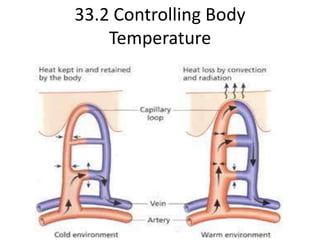More Related Content
Viewers also liked
Viewers also liked (8)
More from Tamara
More from Tamara (20)
Biology 33.2
- 1. 33.2 Controlling Body Temperature
- 2. Ectotherm Animal that relies on interactions with the environment to help it control body temperature.
- 3. Endotherm Animal that generates its own body heat and controls its body temperature from within.
- 4. Key Concept The control of body temperature is important for maintaining homeostasis in vertebrates, particularly in habitats where temperature varies widely with time of day and with season.
- 5. Key Concept Most reptiles, fishes, and amphibians are ectotherms animals whose body temperatures are controlled primarily by picking up heat from, or losing heat to, their environment.
